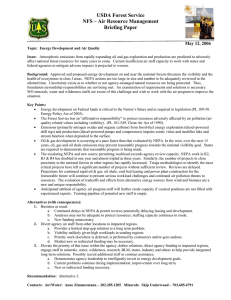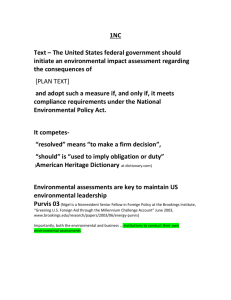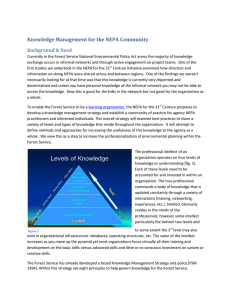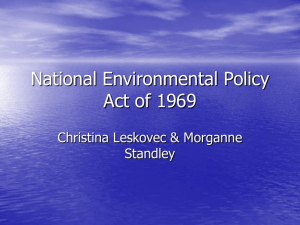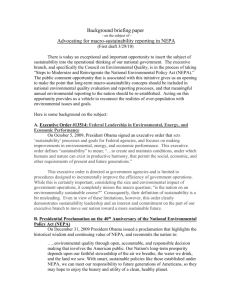Discussion of “Major Federal Actions” Under NEPA
advertisement
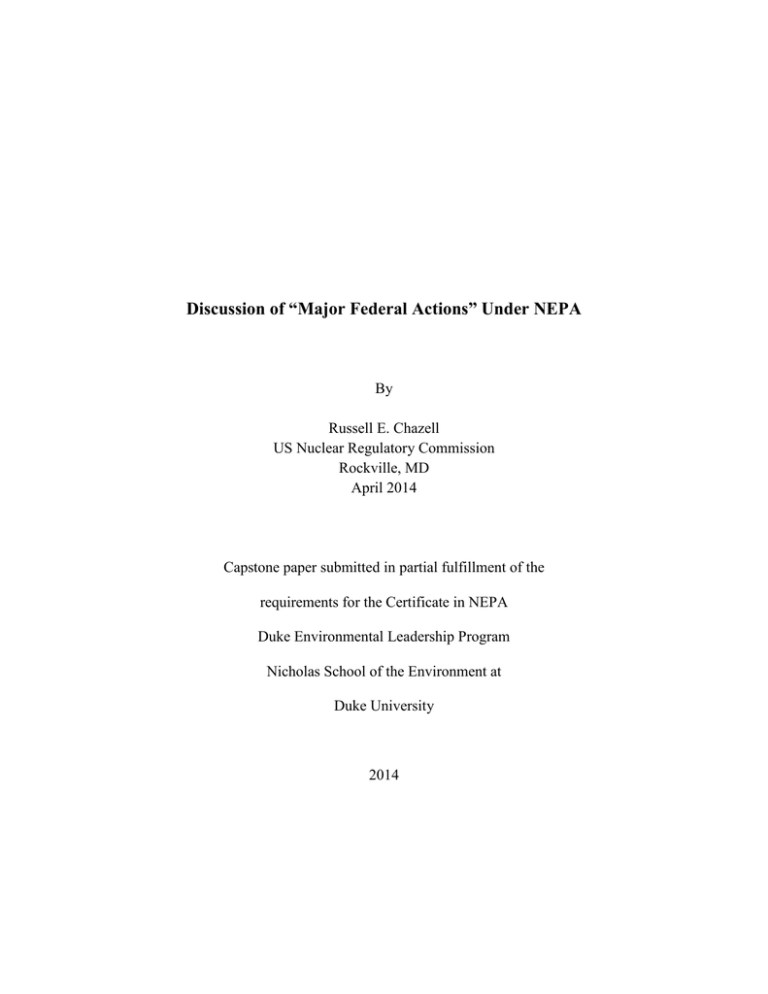
Discussion of “Major Federal Actions” Under NEPA By Russell E. Chazell US Nuclear Regulatory Commission Rockville, MD April 2014 Capstone paper submitted in partial fulfillment of the requirements for the Certificate in NEPA Duke Environmental Leadership Program Nicholas School of the Environment at Duke University 2014 Disclaimer This paper was prepared by an employee of the U.S. Nuclear Regulatory Commission (NRC) on his own time apart from his regular duties. The NRC has neither approved nor disapproved of its content. The views expressed in this paper are those of the author and not necessarily those of the U.S. Nuclear Regulatory Commission. Discussion of “Major Federal Actions” Under NEPA i Abstract Section 102(2)(C) of the NEPA statute requires that significant effects to the human environment be documented in “a detailed statement by the responsible official” for “major Federal actions”. The statute itself does not plainly define what constitutes a major Federal action other than to say that “recommendation[s] and report[s] on proposals” qualify. This capstone paper will discuss the legislative history, case law, and practical application of NEPA’s “major Federal action” concept as it has been interpreted by the Nuclear Regulatory Commission (NRC) and Federal court litigation. This author is particularly interested in the recent decision by the US Circuit Court of Appeals for the District of Columbia Circuit which vacated the NRC’s 2010 Waste Confidence Rule. One of the bases for vacating the rule was the fact that the Court considered the Waste Confidence Rule a major Federal action under NEPA. The paper will conclude with a discussion of the appropriateness, under NEPA, of deeming a policy decision like the Waste Confidence Rule, a major Federal action when the final Agency action, issuing or renewing a license, relies on a separate and distinct environmental impact statement (EIS). Discussion of “Major Federal Actions” Under NEPA ii Table of Contents I. Introduction ..........................................................................................................................1 II. Context of a Major Federal Action under NEPA.................................................................2 III. Definition of a Major Federal Action ..................................................................................3 IV. Interpretation of the Definition ............................................................................................3 a. CEQ..........................................................................................................................3 b. NRC .........................................................................................................................4 c. Case Law ..................................................................................................................5 d. Other Thoughts ........................................................................................................7 V. Why licensing actions are considered Major Federal Actions.............................................8 VI. Is NRC Waste Confidence Rule a Major Federal Action? ................................................10 VII. Case Study: New York v. NRC ...........................................................................................12 VIII. Discussion of the Ruling ....................................................................................................12 IX. Conclusion .........................................................................................................................14 X. References ..........................................................................................................................15 Discussion of “Major Federal Actions” Under NEPA I. 1 Introduction The National Environmental Policy Act of 1969 (NEPA)i was enacted by Congress in an attempt to stop and reverse, where possible, the worsening damage to America’s air, water, and biota from decades of industrial pollution beginning at the start of the industrial revolution in the 19th century. NEPA was intended to force Federal government decision makers to stop and think about how proposed actions bear on the sustainability of the environment. The courts call it taking a “hard look” at the proposed action to inform agency decision making.ii Regardless of what one calls the process, it is intended to drive governmental behavior to reasonable and responsible environmental stewardship. NEPA is not a directive piece of legislation; rather, it is a procedural statute. NEPA cannot force a Federal agency to abandon a proposed project; it can only force the agency to consider the impacts of the proposal on the environment. Of course, if an agency finds itself in Federal court defending its process, it would be prudent for that agency to be able to substantively demonstrate that it carried out the “hard look”iii required by NEPA and that the agency had considered the information derived from the process before making the final decision to proceed with the proposal or not. That substantive demonstration takes the form of a “detailed statement”, now known as an environmental impact statement (EIS), an environmental assessment (EA) or a categorical exclusion (CatX).iv Without such a substantive demonstration, the agency is likely to be enjoined from pursuing the project, or required to readdress the aspects of the agency’s NEPA process the court found lacking.v Additionally, NEPA served as the gateway to a plethora of other environmental laws (or amendments to existing laws) such as CERCLA, RCRA, TSCA, CAA, and CWA.vi These statutes have the legal “teeth” necessary to force individual, corporate, and governmental compliance with their provisions as well as hold actors accountable, civilly and criminally, for their actions.vii The question of whether NEPA – and its follow-on statutory daughters – has worked to improve America’s environment is debatable and outside the scope of this paper. Suffice it to say that there are those that believe, at a minimum, the environment is cleaner and healthier than it was in 1969. Others might even say that today’s American environment is cleaner and Discussion of “Major Federal Actions” Under NEPA 2 healthier than it has been since the beginning of the industrial revolution.viii NEPA has played a part in this success and therefore, viewed in that light, NEPA is an unqualified success. This paper will focus on how an agency decision maker determines which proposals require the “hard look” necessary under NEPA. On its face, the test is simple – “major Federal actions significantly affecting the quality of the human environment….”ix In practicality, defining what constitutes a “major Federal action” is far from simple or straightforward. II. Context of a Major Federal Action under NEPA The primary driver for triggering a NEPA analysis is the undertaking, by the Federal government, of a major Federal action. As stated in the introduction, determining what constitutes a major Federal action was somewhat unclear in the beginning days of NEPA practice. There has been litigation on the issue with the primary question coming down to – as it often does in legal interpretation – defining the concept of “major Federal action” by looking at the different aspects of the definition. This is sort of like “integration by parts” in mathematics. One takes a complex expression, breaks it down into smaller parts, applies a resolution method to each of the parts individually, and then adds those individual resolutions together to arrive at a comprehensive result. In the case of a major Federal action, the NEPA practitioner – usually some Federal agency or its contractor – will determine whether or not the contemplated action constitutes a major Federal action for NEPA purposes. Then, if that action is deemed to be a major Federal action, determining what level of scrutiny – categorical exclusion, environmental analysis, or environmental impact statement – is required. Title II of NEPA establishes the Council of Environmental Quality (CEQ) in the Executive Office of the President.x CEQ is charged with a number of statutory responsibilities related to the effective implementation and compliance with NEPA by executive branch Federal agencies. CEQ rules are set out in Title 40 of the U.S. Code of Federal Regulations (40 CFR) Parts 1500 to 1508.xi The U.S. Nuclear Regulatory Commission (NRC) is an independent agency established by the Energy Reorganization Act of 1974, as amended.xii The NRC has promulgated administrative rules to implement Section 102(2) of NEPA in Title 10 of the U.S. Code of Federal Regulations (10 CFR) Part 51.xiii As an independent agency, the NRC is not bound, per se, by CEQ regulations. However, the Commission has committed to “[e]xamine any Discussion of “Major Federal Actions” Under NEPA 3 future interpretation or change to the Council’s [CEQ] NEPA regulations[.]”xiv Further, in some instances, the Commission has adopted CEQ regulations, including the CEQ definition of a major Federal action.xv III. Definition of a Major Federal Action A “major Federal action” is defined in NEPA as an agency action that “significantly affect[s] the quality of the human environment.”xvi IV. Interpretation of the Definition The term “major Federal action”, in its simplest structure, is comprised of three subordinate terms – “major”, “Federal”, and “action” – all of which require independent definitions thereby adding multiplicative complexity to what might seemingly be a straightforward concept. However, to get to the kernel of the concept, one must “integrate by parts” these varied underlying concepts to attempt to derive a working framework for identifying what agency actions are truly major Federal actions and then to interpret the NEPA requirement of preparing “a detailed statement” to that particular action. As one might imagine, this definitional complexity makes for disparate conclusions between agencies on what, in any given circumstance, qualifies as a major Federal action under NEPA. a. CEQ CEQ has interpreted the NEPA definition of “major Federal action” to “include actions with effects that may be major and which are potentially subject to Federal control and responsibility.”xvii CEQ appears to be defining a word – major – by using the same the word in the definition. Such a practice tends to be problematic as it does not really define the term at hand. CEQ attempts to resolve that circular logic through qualifying the term “major” by stating that “[m]ajor reinforces but does not have a meaning independent of significantly (40 CFR §1508.27).”xviii The qualification of “major” seems to modify the CEQ definition to actions with effects that may be both major and significant. Adding the term “significant” to the mix requires more clarification. Discussion of “Major Federal Actions” Under NEPA 4 CEQ goes on to define “significant” both in terms of “context and intensity”.xix CEQ defines “context” being “that the significance of an action must be analyzed in several contexts such as society as a whole …, the affected region, the affected interests, and the locality. Significance varies with the setting of the proposed action.” “Intensity” is defined as “the severity of impact” and gives a list of considerations to be evaluated to determine intensity such as, among others, “beneficial and adverse” impacts, controversy of the proposed action, and “whether the action is related to other actions with individually insignificant but cumulatively significant impacts.” xx Again, CEQ is defining “significance” using the same term in some evaluations like whether a cumulative impact is “insignificant” but “cumulatively significant.” Such “dog chasing its tail” definitional logic leaves one to conclude that the determination of whether an agency action is “major” or “significant” is an inherently subjective determination. Returning to the base definition from NEPA, one must determine whether the action is a Federal action. CEQ states that actions are Federal in nature if a Federal agency “partly financed, assisted, conducted, regulated, or approved” an action.xxi Further, CEQ also deems “new or revised agency rules, regulations, plans, policies, or procedures; and legislative proposals” as Federal actions.xxii Finally, CEQ defines an action as something that falls into several categories including “[a]doption of official policy”,xxiii “[a]doption of formal plans”,xxiv “[a]doption of programs, such as a group of concerted actions to implement a specific policy or plan; systematic and connected agency decisions allocating agency resources to implement a specific statutory program or executive directive”,xxv and “[a]pproval of specific projects, such as construction or management activities located in a defined geographic area” to include “actions approved by permit or other regulatory decision as well as Federal and Federally assisted activities.”xxvi b. NRC The Commission has adopted the CEQ definition of a major Federal action in its NEPA implementing rules.xxvii By doing so, the Commission has adopted the circular logic and subjectivity of the CEQ definition. However, in some NRC actions, that subjectivity has been resolved because the Commission has dispensed with the exercise of determining whether certain, specific actions are major Federal actions. In these circumstances, the Commission has directed that a detailed statement, or environmental impact statement (EIS), will be developed, Discussion of “Major Federal Actions” Under NEPA 5 by policy, in all instances of similar agency action. Particularly, the Commission has directed that an EIS will be developed for, among others, construction permits and operating licenses for nuclear power plants, licenses to possess and use special nuclear materialsxxviii for processing and fuel fabrication, and licenses to mill uranium or produce uranium hexafluoride.xxix Additionally, the Commission has directed that an EIS may be developed in circumstances where a categorical exclusion would ordinarily suffice.xxx In special cases, the NRC will prepare an EIS in response, for example, to a court order, as is the case with the Waste Confidence Rule resulting from the recent decision by U.S. Circuit Court of Appeals for the District of Columbia Circuitxxxi on the Commission’s Waste Confidence Rule.xxxii c. Case Law Subjectivity generates litigation. Litigation requires interpretation. Interpretation creates precedent that then provides a framework for future implementation and practice. The subjective nature of the definition of a major Federal action has generated litigation since the passage of NEPA in 1969.xxxiii Several early cases took on the challenge of defining a major Federal action under NEPA. Again, one needs to look at all aspects of the term – whether it is major; whether it is Federal; and whether it is significant. The NEPA statute itself defines “Federal” in very broad terms. First, NEPA states that “all agencies of the Federal Government shall – [act]….”xxxiv And, that such action, by Congressional authorization and direction will be “to the fullest extent possible….”xxxv Such strong, all-inclusive language appears to include all Federal entities, including independent agencies like the NRC.xxxvi The Atomic Energy Commission (AEC), predecessor agency to the NRC, argued that NEPA did not apply to it because the Atomic Energy Act of 1954xxxvii did not include environmental protection in the AEC’s statutory mandate. This position was quickly put to bed by D.C. Circuit in the Calvert Cliffs casexxxviii and later by and the U.S. Supreme Court in the Vermont Yankee case.xxxix The Supreme Court decision established that “NEPA contains largely “procedural” requirements that are supplemental to existing statutory requirements of the federal agencies.” (Emphasis added).xl Inasmuch as the NRC is a Federal agency without an exemption, its actions – including licensing actions – are “Federal” actions under NEPA. Discussion of “Major Federal Actions” Under NEPA 6 The determinations of “major” and “significant” are somewhat more complicated. In fact, the early court cases were mixed on whether a “major” action was, per se, a “significant” one. In the case Hanly v. Kleindienst, the court determined that the definition of the word “significant” as contained in NEPA was a stand-alone question of law whose legal determination could be made by them.xli The court characterized the term “significantly” as “amorphous” and stated that almost every major federal action, no matter how limited in scope, has some adverse effect on the human environment.”xlii The court further stated that if Congress had intended for all major Federal actions to require an environmental impact statement, it would not have qualified the language with the term “significant.” Since neither Congress nor CEQ clearly defined “significant” in this context, the court reasoned that “Congress apparently was willing to depend principally upon the agency's good faith determination as to what conduct would be sufficiently serious from an ecological stand-point to require use of the full-scale procedure.”xliii To define “significant” this court ultimately fashioned a two-pronged threshold determination to ascertain whether an action was significant. The Court stated that: we are persuaded that in deciding whether a major federal action will "significantly" affect the quality of the human environment the agency in charge, although vested with broad discretion, should normally be required to review the proposed action in the light of at least two relevant factors: (1) the extent to which the action will cause adverse environmental effects in excess of those created by existing uses in the area affected by it, and (2) the absolute quantitative adverse environmental effects of the action itself, including the cumulative harm that results from its contribution to existing adverse conditions or uses in the affected area. Where conduct conforms to existing uses, its adverse consequences will usually be less significant than when it represents a radical change.xliv Finally, the court reasoned that “it must be recognized that even a slight increase in adverse conditions that form an existing environmental milieu may sometimes threaten harm that is significant. One more factory polluting air and water in an area zoned for industrial use may represent the straw that breaks the back of the environmental camel. Hence the absolute, as well as comparative, effects of a major federal action must be considered.”xlv In short, the court Discussion of “Major Federal Actions” Under NEPA 7 added that “before a preliminary or threshold determination of significance is made the responsible agency must give notice to the public of the proposed major federal action and an opportunity to submit relevant facts which might bear upon the agency's threshold decision.”xlvi These so-called “threshold determinations” are difficult to establish and courts have ruled in contradictory manners (as indicated by the dissent in Kleindienst). Some agencies, including the NRC,xlvii have resolved this challenge by simply making “the distinction [of significance] a programmatic one; that is, all actions under certain programs require environmental impact statements, and all actions under other programs do not.” (Emphasis in the original).xlviii d. Other Thoughts As stated earlier, some agencies, including the NRC have resolved the “major” versus “significant” debate by deeming all actions of certain nature subject to preparation of an environmental impact statement. By doing this, the agency no longer needs to quibble over whether proposed action A needs an EIS and then later defend why proposed action A was deemed EIS-worthy when a similar proposed action B was not; or split hairs over why proposed action A was “significant” when proposed action B was not even though both were major Federal actions. In 10 CFR 51.20(b), the Commission has stated that “[t]he following types of actions require an environmental impact statement or a supplement to an environmental impact statement: (1) Issuance of a limited work authorization or a permit to construct a nuclear power reactor, testing facility, or fuel reprocessing plant under part 50 of this chapter, or issuance of an early site permit under part 52 of this chapter. (2) Issuance or renewal of a full power or design capacity license to operate a nuclear power reactor, testing facility, or fuel reprocessing plant under part 50 of this chapter, or a combined license under part 52 of this chapter. (3) Issuance of a permit to construct or a design capacity license to operate or renewal of a design capacity license to operate an isotopic enrichment plant pursuant to part 50 of this chapter. (4) Conversion of a provisional operating license for a nuclear power reactor, testing facility or fuel reprocessing plant to a full term or design capacity license pursuant to part Discussion of “Major Federal Actions” Under NEPA 8 50 of this chapter if a final environmental impact statement covering full term or design capacity operation has not been previously prepared.” These actions require an environmental impact statement because, in its discretion, the Commission believes that they are both major actions and significantly affect the quality of the human environment. This process, presumably, conserves resources by ensuring a predictable and stable process for both the agency and the applicant. When all parties know that an EIS will be required for certain actions – like licensing a nuclear power plant – those parties can plan accordingly. An additional benefit to the NRC is that, by deeming all nuclear power plant applications EIS-worthy, whether under 10 CFR Part 50 or 10 CFR Part 52, the agency can require applicants to submit an “environmental report” as a part of the application. CEQ regulations permit such practices so long as the agency conducts an independent evaluation of the information submitted.xlix The Commission defines an “environmental report” as “a document submitted to the Commission by an applicant for a permit, license, or other form of permission, or an amendment to or renewal of a permit, license or other form of permission, or by a petitioner for rulemaking, in order to aid the Commission in complying with section 102(2) of NEPA.”l All nuclear power plant applicants are required to submit an environmental report as part of their applications.li V. Why licensing actions are considered Major Federal Actions Many Federal agencies actually build things. The Department of Defense builds military bases and ships and airplanes; the National Park Service builds infrastructure for the Nation’s parks; the Federal Aviation Administration builds control towers; the Bureau of Reclamation builds dams. Other Federal agencies, like the NRC, build nothing. They license others to build things. Yet, these agencies that are merely licensing and not actually building are still subject to the EIS requirements of NEPA because those licensing actions may be considered major Federal actions significantly affecting the quality of the human environment. But wait – it’s a piece of paper – a license. Is the NRC, for example, really undertaking a major Federal action by issuing a license? CEQ thinks so – and the courts have validated their position. Discussion of “Major Federal Actions” Under NEPA CEQ regulations appear to have connected the dots between licensing and a major Federal action thusly: licensing creates effects and are thereby major Federal actions. 40 CFR §1508.18 states that a “’[m]ajor Federal Action’ includes actions with effects that may be major and which are potentially subject to Federal control and responsibility.” (Emphasis added). 40 CFR §1508.18(b)(4) further clarifies by stating that “[a]pproval of specific projects, such construction or management activities located in a defined geographic area. Projects include actions approved by permit or other regulatory decision as well as Federal and Federally assisted activities.” (Emphasis added). The NRC has specifically adopted this definition of a major Federal action.lii Hence, merely licensing a project may give rise to that project being a major Federal action even the Federal agency never turns a single shovelful of dirt. The case law on this concept is extensive starting with the 1971 Calvert Cliffs case. In that case the D.C. Circuit, throughout its opinion, accepted as a given that issuance of a license constitutes a major Federal action.liii Specifically, the Court states that: The procedure for environmental study and consideration set up by the Appendix D rules is as follows: Each applicant for an initial construction permit must submit to the Commission his own "environmental report,” presenting his assessment of the environmental impact of the planned facility and possible alternatives which would alter the impact. When construction is completed and the applicant applies for a license to operate the new facility, he must again submit an "environmental report" noting any factors which have changed since the original report. At each stage, the Commission's regulatory staff must take the applicant's report and prepare its own "detailed statement" of environmental costs, benefits and alternatives. The statement will then be circulated to other interested and responsible agencies and made available to the public. After comments are received from those sources, the staff must prepare a final "detailed statement" and make a final recommendation on the application for a construction permit or operating license.liv (Emphasis added). The Court in this case accepted the Atomic Energy Commission’s rule requiring a “detailed statement” – read as EIS – before a licensing decision could be made. 9 Discussion of “Major Federal Actions” Under NEPA 10 Other cases that stand for the proposition that licensing actions alone are sufficient to constitute a major Federal action include Scientists' Institute for Public Information, Inc. v. Atomic Energy Commission, 481 F.2d 1079, 1088 (D.C. Cir. 1973), (there is "Federal action" within the meaning of the statute not only when an agency proposes to build a facility itself, but also whenever an agency makes a decision which permits action by other parties which will affect the quality of the environment.); Foundation on Economic Trends v. Heckler, 756 F.2d 143, 153 (D.C. Cir. 1985), ([t]he government has conceded that the approval is a "major action" and that it does not fall into a categorical exclusion to the EIS requirements.); and Natural Resources Defense Council, Inc. v. United States E.P.A., 822 F.2d 104, 128 (D.C. Cir. 1987), (unless the construction itself is pursuant to federal financial assistance, NEPA review may only be conducted with regard to the issuance of a discharge permit, which constitutes, of course, the major Federal action.). VI. Is NRC Waste Confidence Rule a Major Federal Action? In 1977, the Commission advanced a policy wherein it “would not continue to license reactors if it did not have reasonable confidence that the wastes can and will in due course be disposed of safely.” lv Additionally, in Minnesota v. NRC, the U.S. Circuit Court of Appeals for the District of Columbia Circuit “directed the Commission to consider ‘whether there is reasonable assurance that an off-site storage solution [for spent fuel] will be available by … the expiration of the plants’ operating licenses, and if not, whether there is reasonable assurance that the fuel can be stored safely at the sites beyond those dates.”lvi To implement that policy decision and Court directive, the Commission promulgated 10 CFR 51.23 otherwise known as the Waste Confidence Rule in 1984.lvii Generically applicable, the rule intended to resolve the question of the safety and environmental impacts of high-level waste and spent nuclear fuel by stating, as a policy matter, that the Commission believed that spent nuclear fuel could be stored in the facility spent fuel pool or in an onside independent spent fuel storage installation (ISFSI) for up to thirty years after a plant ceased operations. The rule further stated that Commission “believe[d] there [was] reasonable assurance that one or more mined geologic repositories for commercial high-level radioactive waste and spent fuel [would] be available by the year 20072009.”lviii The promulgation of this rule eliminated any consideration of post-operation spent Discussion of “Major Federal Actions” Under NEPA 11 fuel storage from the site-specific licensing decisions and no discussion of it was required in “any environmental report, environmental impact statement, environmental assessment or other analysis prepared in connection with the issuance or amendment of an operating license for a nuclear reactor or in connection with the issuance of an initial license for storage of spent fuel at an ISFSI, and any amendment thereto.”lix Finally, the rule specifically states that it does not alter any environmental review requirements during the term of the operating license or in an ISFSI license proceeding. There is nothing in the Statement of Consideration for the 1984 rule that would indicate the Commission considered the rule to constitute a major Federal action under NEPA, nor was there any direction by the Court in the Minnesota case that such a rulemaking would constitute a major Federal action under NEPA.lx Further, by operation of the 1984 Waste Confidence Rule, consideration of spent fuel storage was not part of the environmental analysis. This decision was reviewed in 1990 wherein the Commission checked the validity of its five findings from the 1984 rule. At that time, the Commission revised two of the five findings in light of new circumstances. Most significantly, the Commission changed their prediction of the availability of a mined geologic repository to “the first quarter of the twenty-first century.”lxi The change reflected the reality that the mined repository would most likely not be in service by 2009 as predicted in the 1984 rule. In doing so, the Commission believed that “[t]o specify a year for the expected availability of a repository decades hence would misleadingly imply a degree of precision now unattainable.” lxii The Commission also, in this update, extended the periodic review of the Waste Confidence Decision from every five years to every ten years. Finally, in 2010, the Commission again revised the Decision and stated that, given the apparent demise of Yucca Mountain, that a repository would be available “when necessary” instead of setting a specific time window.lxiii The Commission’s Waste Confidence Decision raises the question whether a mere opinion – the prognostication of the Commission as to when a geologic SNF repository would be built – constitutes a major Federal action under NEPA. Given the lack of “detailed statements” supporting this prognostication in 1984, 1990, and 2010, it appears that the Commission did not consider the “Decision” a major Federal action. Moreover, the absence of such a discussion in 1979 in Minnesota seems to have set such a tone. Additionally, this question is exacerbated by the fact that no licensing actions would proceed solely based on the Waste Confidence Decision. Discussion of “Major Federal Actions” Under NEPA 12 The Waste Confidence Decision was a consequence of the Court’s direction in Minnesota, not a pre-determined step in nuclear reactor power plant licensing. The D.C Circuit in New York v. NRC addressed this issue in 2012.lxiv VII. Case Study: New York v. NRC The Commission had stated that they would revisit the Waste Confidence rule periodically and did so in 2010. The 2010 update modified two of the five findings – the timeline for rollout of a National geologic repository and the length of time that spent fuel could be stored onsite after the cessation of plant operations. The Department of Energy had, that same year, attempted to withdraw its application to license the Yucca Mountain repository.lxv By revising the prognostication of when a geologic repository would be available, it seems that the Commission “was no doubt influenced by the recent shelving of the Yucca Mountain proposal”lxvi when it changed the language of the Waste Confidence Decision repository availability from the first quarter of the twenty-first century to that of “when necessary.” This change of position, as well as the revised finding that spent nuclear fuel could be stored onsite for up to sixty years after cessation of plant operations, caused a lawsuit to break out challenging the 2010 revision. The State of New York and the Prairie Island Indian Community were the Petitioners and a number of other parties participated as intervenors.lxvii There were a number of issues argued in New York v. NRC but this paper is limited to only one of the bases for vacating the rule – the fact that the Court considered the Waste Confidence Rule a major Federal action under NEPA.lxviii In short, the U.S. Circuit Court of Appeals for the District of Columbia Circuit vacated the Commission’s 2010 Waste Confidence Decision update and the Temporary Storage Rule and remanded it to the Commission “for further proceedings consistent with this opinion.”lxix VIII. Discussion of the Ruling The first issue the Court took up was whether the Waste Confidence Decision constituted a major Federal action under NEPA. Notwithstanding the three decades of Commission precedent wherein waste confidence decisions were not considered major Federal actions, the Court ruled that this one was. The opinion states that “[the Court has] long held that NEPA Discussion of “Major Federal Actions” Under NEPA 13 requires that ‘environmental issues be considered at every important stage in the decision making process concerning a particular action.’”lxx The Court stated that, because the “WCD makes generic findings that have a preclusive effects in all future licensing decisions – it is a predetermined ‘stage’ of each licensing decision[,]”lxxi and thus a major Federal action. The Court continued by citing CEQ regulation 40 CFR 1508.18, discussed earlier in this paper, that defines a major Federal action as one having “indirect effects, which are caused by the action and are later in time or farther removed in distance, but are still reasonably foreseeable.” Again, the Commission has adopted the CEQ definition of a major Federal action from 40 CFR 1508.18. The Court states that “[i]t is not only reasonably foreseeable but eminently clear that the WCD will be used to enable licensing decisions based on its findings.”lxxii Additionally, the Court quotes Andrus v. Sierra Club that states, “CEQ’s NEPA interpretations are entitled to substantial deference.”lxxiii Finally, the Court states that, given the language of the Commission’s rules at 10 C.F.R 51.23(b), the WCD “renders uncontestable general conclusions about the environmental effects of general plant licensure that will apply in every licensing decision.”lxxiv The Court reasoned that, since these general conclusions cannot be contested during licensing, the WCD is a “pre-determined ‘stage’ of each licensing decision” and thus a major Federal action requiring an environmental impact statement, or an environmental assessment with an attendant finding of no significant impact. The Court’s rationale for deeming the Waste Confidence Decision a major Federal action are based on the fact that the “general conclusions [from the Waste Confidence Decision] about the environmental effects of general plant licensure” are not contestable in the subsequent licensing decision. Presumably, that rationale is because the Commission does not allow challenges to its regulations in licensing proceedings.lxxv However, there are several ways, under Commission practice, in which those conclusions are contestable – through public comment during initial rulemaking,lxxvi by administrative litigation during license hearings when “new and significant” information emerges,lxxvii and by petitions for rulemaking.lxxviii The NRC’s rulemaking processes allow for public comment, usually for 75 to 90 days, during which comments are accepted for consideration.lxxix The NRC staff reviews and analyzes these comments and, when persuaded, revises the rule to reflect the substance of the comment. Discussion of “Major Federal Actions” Under NEPA 14 Secondly, during licensing proceedings – those same proceedings where the Waste Confidence Decision is operative – putative intervenors may “make their case” to the Atomic Safety and Licensing Board or to the Commission as appropriate. If the petitioners are able to meet the admissibility standards of 10 CFR 2.309(f), they may be admitted as parties to the licensing proceeding wherein they may have an opportunity to challenge WCD conclusions on the basis of emergent “new and significant” informationlxxx if they are able to show “special circumstances” under 10 CFR § 2.335(b).lxxxi Finally, anyone can petition the Commission at any time to engage in rulemaking under 10 CFR § 2.802.lxxxii This mechanism could be used to challenge or revise the language or conclusions of the Waste Confidence rule with persuasive justification. Certainly, these three mechanisms to address alleged deficiencies with the Waste Confidence Decision are not easy nor are they straightforward. However, they are no more burdensome than the contemporaneous challenge during licensing that, the DC Circuit implies would be necessary for the Waste Confidence Decision to cease to be a “pre-determined stage” of licensing. Reliance on these three administrative processes for challenge to alleged WCD defects would have preserved the Commission’s decades-long precedent that WCD, standing alone, is not a major Federal action. In any event, the Commission did not appeal the 2012 New York v. NRC decision and, therefore, development of an EIS to support a replacement rule to the vacated 2010 WCD update is now underway. As of this writing, the NRC staff has issued a draft WCD EIS. IX. Conclusion The concept of a major Federal action under NEPA is not as straightforward or intuitive as it may appear by simply reading NEPA. When one delves into the elements of the term, one quickly realizes that the terms “major” and “significant” muddy the definitional waters greatly. As seen by the discussion above and by the references list below, there have literally been entire books written on this seemingly simple term. Add to that all the case law that has arisen over the past four decades and one sees that ascertaining whether a specific action qualifies as a major Federal action is many times a subjective inquiry dependent on broad interpretation and differences of opinion. With regard to NRC licensing actions, NEPA itself, the Courts, and regulations promulgated by CEQ and the Commission, have by decree, removed the guesswork from the inquiry. There is no “integration by parts” for the NRC NEPA practitioner to determine whether Discussion of “Major Federal Actions” Under NEPA 15 one has a major Federal action at hand. Once merely needs to look at NEPA Section 102(2)(C), Minnesota v NRC, New York v. NRC (2009), New York v. NRC (2012), 40 CFR 1508.18 (CEQ), and 10 CFR 51.20(b) (NRC). Perhaps calculating reactor power densities would be easier. X. References Cases a. Andrus v. Sierra Club, 442 U.S. 347 b. Calvert Cliffs’ Coordinating Commission Inc. v. United States Atomic Energy Commission, 449 F.2d 1109 c. Hanly v. Mitchell, 460 F.2d 640 d. Hanly v. Kleindeinst, 471 F.2d 823 e. Kleppe v. Sierra Club, 427 U.S. 390 f. Minnesota v. NRC, 602 F.2d 412 g. New York v. NRC, 589 F.3d 551 h. New York v. NRC, 681 F.3d 471 i. Vermont Yankee Nuclear Power Corp. v. Natural Resources Defense Council, 435 U.S. 519 Books and Articles a. Anderson, Frederick R., NEPA in the Courts; A Legal Analysis of the National Environmental Policy Act, Johns Hopkins University Press (1973). b. Anderson, Frederick R., Glicksman, Robert L. Glicksman, Daniel R. Mandelker, and Dan Tarlock, Environmental Protection Law and Policy, 3rd Edition, Aspen Law & Business, (1999). c. Baker, Martin S., Joseph S. Kaming, and Richard E. Morrison; Environmental Impact Statements: A Guide to Preparation and Review; Practicing Law Institute, New York City (1977). d. Bonine and McGarity, The Law of Environmental Protection, Cases – Legislation – Policies, 2d Edition (1992). Discussion of “Major Federal Actions” Under NEPA e. 16 Fogleman, Valerie M., Guide to the National Environmental Policy Act: Interpretations, Applications, and Compliance, Quorum Books (1990). f. Harnett, Hillary H., New York v. U.S. Nuclear Regulatory Commission, Harvard Environmental Law Review, Volume 37, (2013). g. Liroff, Richard A., National Policy for the Environment: NEPA and Its Aftermath, Indiana University Press (1976). h. Rodgers, W., Environmental Law 763 (1977) i. Smith, Maxwell C. and Catherine E. Kanatas, Acting with No Regret: A Twenty- Five Year Retrospective of Marsh v. Oregon Natural Resources Defense Council, Social Science Research Network (2013). j. Sullivan, Thomas F.P. (Ed.), Environmental Law Handbook, 14th Edition, Government Institutes, Inc., Rockville, Maryland, (1997) i 42 USC §4332 Natural Resources Defense Council v. Morton, 458 F.2d 827, 838 (D.C. Cir. 1972) iii Kleppe v. Sierra Club, 427 U.S. 390, 410 n. 21, (1976) iv 42 U.S.C §4332 The categorical exclusion is included here because, in this author’s opinion, a categorical exclusion is only arrived after a substantive review of similar actions and a finding by the decision maker that such are can be generically determined to have no adverse environmental impact. In short, before a category of actions is deemed a CatX, the decision maker studied that category of actions. v Hanly v. Mitchell, 2 ELR 20216, 20220 (2d Cir.), 460 F.2d 640; and Hanly v. Kleindeinst, 2 ELR 20717, 20723, 471 F.2d 823 (2d Cir.); both as cited in Liroff at 167 vi Clean Air Act Amendments of 1970, 42 U.S.C. §7401 et seq. Federal Water Pollution Control Act Amendments of 1972, 33 U.S.C. § 1251 et seq. Resource Conservation and Recovery Act of 1976, 42 U.S.C § 6901 et seq. Toxic Substances Control Act of 1976, 15 U.S.C. §2605 et seq. Comprehensive Environmental Response, Compensation, and Liability Act of 1980, 42 U.S.C § 9601 et seq. vii A discussion of enforcement provisions under CERCLA and RCRA can be found at http://www.epa.gov/region1/enforcement/superfund/. viii http://www.bloomberg.com/slideshow/2012-09-18/world-s-top-environmental-success-stories.html#slide1 ix NEPA § 102(2)(C), (42 U.S.C. § 4332) x NEPA § 202 (42 U.S.C §4342) xi NEPA § 204 (42 U.S.C §4344) xii 42 USC §5841(a)(1) xiii 10 CFR §51.2 xiv 10 CFR §51.10(b)(1). xv See as examples 10 CFR §51.10(b)(2) and 10 CFR Part 51, Appendix A to Subpart A, passim. xvi 42 USC §4332(C). This characterization of agency action is modified by the term “other” in the text of the NEPA section. The use of such a modifier implies that the preceding items in the clause – “every recommendation or report on proposals for legislation” – are also major Federal actions under NEPA. xvii 40 CFR §1508.18 xviii Id. xix 40 CFR §1508.27 ii Discussion of “Major Federal Actions” Under NEPA xx 17 Id. 40 CFR §1508.18 xxii Id. xxiii 40 CFR §1508.18(b)(1) xxiv 40 CFR §1508.18(b)(2) xxv 40 CFR §1508.18(b)(3) xxvi 40 CFR §1508.18(b)(4) xxvii 10 CFR §51.14(b) xxviii Special nuclear materials are defined as “(1) plutonium, uranium-233, uranium enriched in the isotope-233 or in the isotope-235, and any other material which the Commission, pursuant to the provisions of section 51 of the [Atomic Energy] act, determines to be special nuclear material, but does not include source material; or (2) any material artificially enriched by any of the foregoing, but does not include source material. (10 CFR §50.2) xxix 10 CFR 51.20(b) xxx 10 CFR 51.20(b)(14) xxxi New York v. NRC, 681 F.3d 471 (D.C. Cir. 2012) xxxii 10 CFR §51.23 xxxiii As of 1973, one author stated that “[t]he phrase, ‘major Federal action significantly affecting the quality of the human environment,’ has engendered the bulk of litigation under NEPA.” See Anderson (1973) at 57. xxxiv NEPA §102 (42 U.S.C §4332). xxxv Id. xxxvi Only the Environmental Protection Agency has been exempted from the provisions of NEPA, albeit in a limited way, on the basis that EPA “has statutory responsibility for the protection of the environment.” See Sullivan at 533. xxxvii 42 U.S.C. §2011 et seq. xxxviii Calvert Cliffs’ Coordinating Commission Inc. v. United States Atomic Energy Commission, 449 F.2d 1109 (D.C. Cir. 1971). xxxix Vermont Yankee Nuclear Power Corp. v. Natural Resources Defense Council, 435 U.S. 519 (1978). xl Sullivan at 533. xli Hanly v. Kleindienst, 471 F.2d 823 (2d Cir. 1972) at 829. xlii Id., at 830. xliii Id. xliv Id., at 830-831. xlv Id., at 831. xlvi Id. at 836. xlvii See 10 CFR 51.20(b) and 49 Fed. Reg. 34,658 xlviii Baker at 64. xlix 40 CFR §1506.5. l 10 CFR §51.14 li 10 CFR §51.45 lii 10 CFR §51.14(b) liii Calvert Cliffs' Coordinating Committee, Inc. v. United States Atomic Energy Commission, 449 F.2d 1109 (D.C. Cir. 1971) liv Id. at 1116. lv 42 Fed. Reg. 34391 at 34393. lvi Minnesota v. NRC, 602 F.2d 412 (D.C. Cir. 1979) lvii 49 Fed. Reg, 34658 lviii 49 Fed. Reg 34694 lix Id. lx Minnesota v. NRC, 602 F.2d 412 (D.C. Cir. 1979), passim lxi 55 Fed. Reg. 38474 lxii Id. at 38475. lxiii 75 Fed. Reg. 81032 lxiv New York v. NRC, 681 F.3d 471 (D.C. Cir. 2012) xxi Discussion of “Major Federal Actions” Under NEPA lxv 18 The legality of DOE’s withdrawal of its Yucca Mountain application became the subject of litigation because, under the Nuclear Waste Policy Act of 1982, DOE was required to submit, and NRC to evaluate, an application for a repository at Yucca Mountain. (Pub. L No. 100-203, Title V, §§ 5011-5012 (1987) (amending 42 U.S.C. §§ 1013210134), as cited in Harnett, New York v. U.S. Nuclear Regulatory Commission, Harvard Environmental Law Review, Vol. 37, p. 591, Fn 13. lxvi Harnett at 593. lxvii Intervenors included the States of New Jersey, Vermont, and Connecticut; and some environmental advocacy groups. The Nuclear Energy Institute participated in support of the respondents. lxviii New York v. NRC at 473 lxix Id., at 483 lxx Id. at 476, citing Calvert Cliffs’ Coordinating Comm. Inc. v. Atomic Energy Comm’n, 449 F.2d. 1109, 1118 (D.C. Cir. 1971) lxxi Id. lxxii Id. at 477 lxxiii 442 U.S. 347, 358 (1979) lxxiv New York v. NRC at 477. 10 C.F.R. 51.23(b) states that “no discussion of any environmental impact of spent fuel storage in reactor facility storage pools or independent spent fuel storage installations (ISFSI) for the period following the term of the reactor operating license or amendment, reactor combined license or amendment, or initial ISFSI license or amendment for which application is made, is required in any environmental report, environmental impact statement, environmental assessment, or other analysis prepared in connection with the issuance or amendment of an operating license for a nuclear power reactor under parts 50 and 54 of this chapter, or issuance or amendment of a combined license for a nuclear power reactor under parts 52 and 54 of this chapter, or the issuance of an initial license for storage of spent fuel at an ISFSI, or any amendment thereto.” lxxv 10 CFR § 2.335 lxxvi See Administrative Procedures Act, 5 U.S.C § 553(c) lxxvii 10 CFR § 2.335(b). In this context, “new and significant” information may serve as the “special circumstances with respect to the subject matter of the particular proceeding [] such that the application of the rule or regulation (or a provision of it) would not serve the purposes for which the rule or regulation was adopted.” lxxviii 10 CFR § 2.802 lxxix http://www.nrc.gov/about-nrc/regulatory/rulemaking/rulemaking-process.html lxxx There is an excellent article by two NRC staff attorneys discussing the meaning of “new and significant” information under NEPA titled “Acting with No Regret: A Twenty-Five Year Retrospective of Marsh v. Oregon Natural Resources Defense Council.” (http://papers.ssrn.com/sol3/papers.cfm?abstract_id=2354803) lxxxi Id., footnote lxxvii lxxxii 10 CFR § 2.802 allows “[a]ny interested person [to] petition the Commission to issue, amend or rescind any regulation.”

